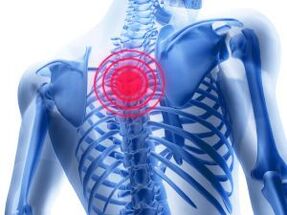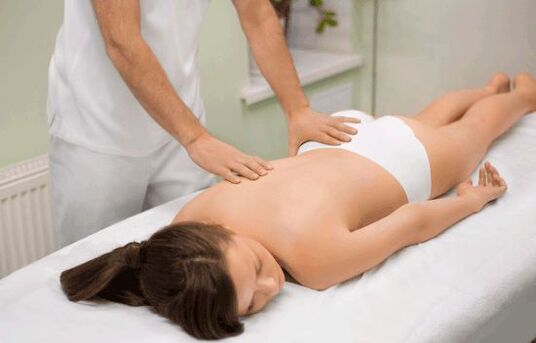
Clinically, thoracic osteochondrosis (chondrosis) is manifested by sharp, piercing or dull, aching, crunching and clicking pains when bending, stiffness.
For the pathology, the characteristic and numerous specific symptoms are a feeling of lack of air when inhaling, discomfort in the heart region and even a sore throat.
The treatment of the pathology is mainly conservative with pharmacological drugs. Physiotherapy procedures, massage sessions are also performed, and chiropractors are used.
If such treatment is ineffective, the patient is shown surgery.
Symptom details
Symptoms of osteochondrosis of the thoracic spine never appear all at once. At the initial stage of the development of this degenerative-dystrophic pathology, only mild discomfort in the back is noted. Patients take them for trivial fatigue after a hard day at work, they clear the "numb" muscles due to a long stay in one position of the body.
But the intensity of the discomfort is slowly, steadily increasing. Unpleasant sensations are replaced by severe pain, complicated by a limited range of motion, dizziness and headache. In medicine, all symptoms of osteochondrosis of a given localization are divided into several groups. This helps diagnose it faster and determine treatment tactics.
On a note!Symptoms of thoracic osteochondrosis in men and women do not differ in character, severity or localization. But in the stronger sex, they can arise a little later due to the stronger musculoskeletal system. Also, some men have erectile dysfunction against the background of osteochondrosis.
Vertebral symptoms
Under the influence of unfavorable factors (hypothermia, increased physical activity), a long-term remission of thoracic osteochondrosis can be interrupted by a sudden attack of acute pain. Even more often, it is provoked by a long stay in one position of the body, for example in a sitting position. If a person abruptly stands up, then there is such severe pain in the back that he loses the ability to move for several minutes.
In medicine, this condition is called dorsago. Differs from ordinary pain in concomitant symptoms:
- a feeling of lack of air when inhaling;
- severe stiffness.
The course of the pathology is often complicated by back pain - pain in the thoracic spine, the intensity of which gradually increases. Increase with flexion, turning the body to the sides. In order not to feel pain, a person takes a forced position. At the same time, it involuntarily tenses the back muscles, involuntarily causing them to overload. Now they also start to hurt, especially when they walk.
Extravertebral symptoms
With the development of thoracic osteochondrosis, the intervertebral discs thin and destroy. These cartilage pads can no longer distribute the resulting loads, they exclude the impact of the vertebrae against each other. A compensatory response of the body is activated: the bone structures begin to deform with the formation of growths. They press on sensitive nerve endings, violate the spinal canal. Therefore, there are specific symptoms of thoracic osteochondrosis in women and men: loss of sensation of certain parts of the body, burning sensation and creeping "goosebumps".
Important! Osteochondrosis of the thoracic localization is often manifested by dry and unproductive cough, sore throat, feeling of coma and urinary disorders.
But that is not all. The spinal roots are responsible not only for the innervation (transmission of nerve impulses) of the spinal column, but also of the internal organs. Therefore, when they are violated, there are unpleasant sensations from the liver, kidneys, digestive tract, myocardium. What are the uncharacteristic signs of back pathologies manifested by thoracic osteochondrosis:
- pain in the heart region, identical to the recurrence of angina pectoris, shortness of breath, feeling of "compression" of the heart;
- panic attacks, psychoemotional instability, unreasonable fear, anxiety, sleep disturbances;
- discomfort in the epigastric region, bouts of nausea, which sometimes lead to vomiting, sour belching, swelling, churning and rumbling;
- peristalsis disorders - constipation or diarrhea;
- persistent, labored breathing with sobbing.
The pains are not localized directly on the site of the destroyed intervertebral disc and (or) the formed intervertebral hernia. They radiate along the course of the nerve. The signs of osteochondrosis of the thoracic region can be masked by renal colic, symptoms of gastritis, gastric ulcers, hepatitis, pancreatitis, cholecystitis and even gastroenteritis.
Compression myelopathy
This is the name of the extravertebral syndrome, which is rarely observed in clinical practice. It is observed at 3-4 stages of the disease, when, due to the loss of stability of the vertebral segment, the nucleus pulposus protrudes beyond the fibrous ring. An intervertebral hernia is formed, which constantly presses on the spinal cord. At an appointment with a vertebrologist or neurologist, patients complain of frequent pain in the girdle radiating to the groin area. At the same time, there are feelings of weakness, numbness in the lower limbs.
Against the background of the violation of the spinal cord, innervation is severely disturbed. In the absence of treatment, the functional activity of the organs located in the small pelvis decreases. Compression myelopathy causes problems with bowel movements. And due to the pronounced narrowing of the diameter of the spinal canal, the sensitivity of the legs decreases. In severe cases, patients are diagnosed with paresis (partial or complete paralysis) of one or two lower limbs.
Symptoms of remission
Outside of relapses, osteochondrosis of the chest almost does not bother a person. Occasionally, there is a pulling, aching, dull back pain that usually subsides after a long rest. But it is worth at least slightly increasing the load on the spine, lifting a heavy object or bending over, as follows the next relapse. It can be triggered by such factors:
- stressful situations, depressive states;
- hypothermia, sudden changes in temperature;
- prolonged stay in one position of the body;
- alcohol abuse;
- unbalanced diet, lack of foods rich in calcium, phosphorus, manganese, molybdenum in the diet.
Sometimes the remission phase ends because a person tries to avoid another relapse. Visit a chiropractor or massage therapist with a dubious reputation or little practical experience. An attempt to lengthen the spine leads to another exacerbation.
The main methods of treatment
It is not yet possible to completely cure the pathology, so all the efforts of doctors are aimed at improving the patient's well-being. Patients are recommended to wear orthopedic products (corsets, bandages), which fix the vertebral structures, preventing their displacement. Drugs of various clinical and pharmacological groups are prescribed, physiotherapeutic measures and physiotherapy exercises are performed.

The chiropractor's hand movements aim to increase the spaces between the vertebrae, which decrease in thoracic osteochondrosis.
Important!With high-severity thoracic osteochondrosis, conservative treatment is useless. Patients are immediately offered surgery: excision of an intervertebral hernia, arthrodesis, placement of implants in place of a damaged disc, bone grafting.
Pharmacological therapy
Treatment of osteochondrosis of the thoracic spine is aimed at eliminating all symptoms, inhibition of destructive and degenerative processes. During periods of exacerbation, solutions for parenteral administration are used, which show effects after 5-10 minutes. Then the result is consolidated by following a course of tablet preparations, applying ointments and gels. In the phase of remission, mainly external agents are used, which have a more gentle effect on the body.
Non-steroidal anti-inflammatory drugs (NSAIDs)
This is the most commonly used group of drugs in the complex treatment of thoracic osteochondrosis. Their active ingredients block the biosynthesis of pain, inflammation and fever mediators from arachidonic acids. Even after a single use of NSAIDs, a person's well-being improves significantly:
- the severity of the pain syndrome decreases;
- the unpleasant creak that occurs when the body turns and tilts disappears;
- inflammatory processes in soft tissues weaken, edema resolves;
- the range of motion in the thoracic region increases.
To stop relapses, intramuscular solutions are used. Preparations in capsules or tablets can cope with moderate pain. And ointments and gels quickly eliminate mild discomfort.
Prepared with B vitamins
Preparations with vitamins of group B cope well with disorders of innervation, improve the transmission of nerve impulses to the central and peripheral nervous system, stimulate the restoration of damaged spinal roots. The composition of the funds is represented by thiamine, riboflavin, pyridoxine, cyanocobalamin.
In the first week of therapy, intramuscular administration of drugs is practiced, which, in addition to vitamins, contain lidocaine, which instantly eliminates pain. And then, for a month, patients are shown taking pills.
Glucocorticosteroids
The use of these synthetic analogues of hormones, produced by the adrenal glands, is practiced when the safest means are ineffective. Glucocorticosteroids are prescribed to patients with acute and penetrating back pain, which radiates to internal organs. Drugs can be taken orally, but much more often they are administered parenterally, even in places of destroyed discs.
Glucocorticosteroids have a wide range of contraindications and potential side effects. Long-term treatment of chondrosis of the thoracic spine with hormones leads to damage to the tissues of the liver, kidneys and stomach. Therefore their use is prohibited in patients with cirrhosis, peptic ulcer, renal insufficiency and osteoporosis.
Muscle relaxants
Back pain is often attributed to increased skeletal muscle tone. To relax it, muscle relaxants are used, first in the form of solutions for parenteral administration, and then in tablets. Medicines relieve muscle spasm that causes spinal root compression. Which muscle relaxants are most effective:
- blocking polysynaptic reflexes;
- relax spasmodic muscles;
- reducing the release of prostaglandins.
Drugs are rarely used for monotherapy. Treatment of thoracic chondrosis is carried out with muscle relaxants in combination with glucocorticosteroids or non-steroidal anti-inflammatory drugs. Their significant drawback is the rather rapid formation of addiction, so it is forbidden to use them for more than a week.
Chondroprotector
Unlike drugs that eliminate the symptoms of thoracic osteochondrosis, such drugs are also used for pathogenetic therapy. This is the only group of drugs capable of increasing the production of chondrocytes, which are necessary for the partial restoration of cartilaginous intervertebral discs. All the therapeutic effects of chondroprotectors are due to the high content of glucosamine and / or chondroitin.
But not just for the ability to restore discs, chondroprotectors are valued. Their components light up in the area of the damaged vertebral segment. After 2-3 weeks, the maximum therapeutic concentration of glucosamine and chondroitin is created. Now the drugs are starting to show marked analgesic, anti-inflammatory and anti-edematous activity.
Recommendation!It is recommended to treat osteochondrosis with chondroprotectors in the form of injection solutions or tablets. Despite all the assurances of the manufacturers about the effectiveness of ointments and creams, they have not been able to provide a basis of evidence for their therapeutic efficacy.
Non-drug treatment
Treatment of osteochondrosis of the thoracic region with pharmacological drugs must necessarily be combined with regular physical education. Physical therapy is the most effective therapy method for avoiding disability. Thanks to daily training, the muscular structure of the back and the ligamentous-tendon apparatus of the thoracic region are strengthened, the production of synovial fluid that feeds the vertebral structures is improved. The set of exercises is determined by the physician of physical therapy after studying the results of X-ray diagnostics. He is present at the first classes, monitors the dosage of loads.
The manual therapy of osteochondrosis is also practiced, aimed at increasing the spaces between the discs and the vertebrae. Dry or underwater traction (traction) of the spine is performed, and at home - hanging on the bar. The effectiveness of manual therapy increases with the simultaneous conduct of physiotherapy:
- electrophoresis;
- laser therapy;
- magnetotherapy;
- ultraviolet radiation;
- diadynamic currents.
Patients are shown 10-15 sessions of classical, vacuum, Scandinavian acupressure. Also useful are hirudotherapy, acupuncture, thermal treatments with radon and hydrogen sulphide baths.
Only with the help of an integrated approach to the treatment of thoracic osteochondrosis it is possible to exclude further damage to the discs and deformities of the vertebrae. Compliance with the doctor's recommendations helps to get rid of all symptoms of chronic pathology as soon as possible.













































